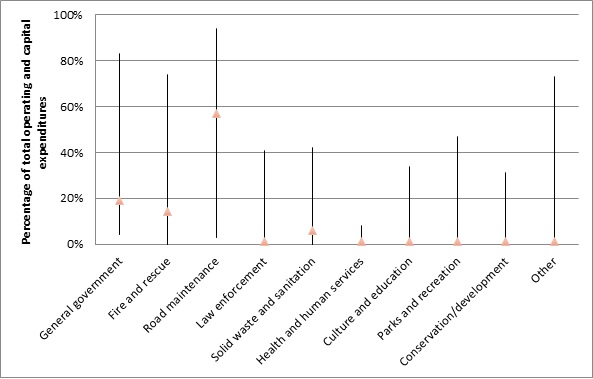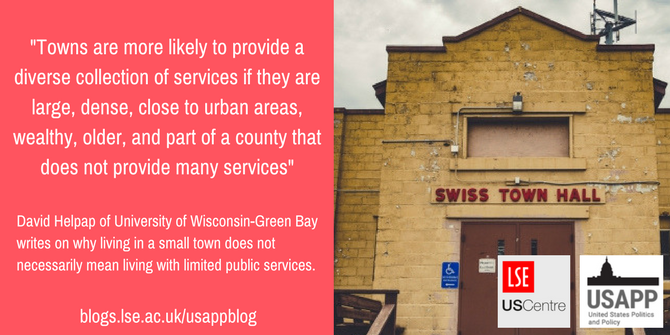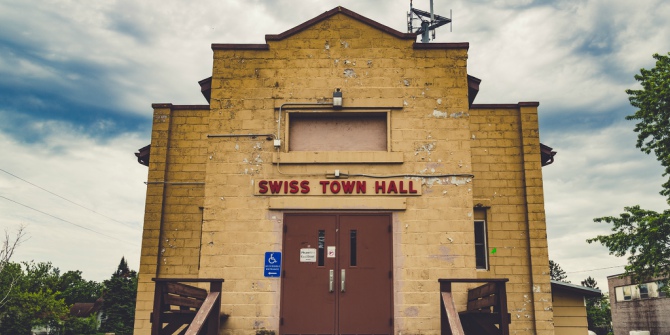 Those who live in cities typically enjoy a greater diversity of public services compared to those living in small towns and rural communities. But, in recent years some cities have reduced the services they provide while other, smaller communities have been able to dedicate significant public resources towards a greater variety of public goods. In new research using data from small towns in Wisconsin, David J. Helpap finds that towns are more likely to provide a more diverse collection of services if they are large, dense, close to urban areas, wealthy, older, and part of a county that does not provide many services.
Those who live in cities typically enjoy a greater diversity of public services compared to those living in small towns and rural communities. But, in recent years some cities have reduced the services they provide while other, smaller communities have been able to dedicate significant public resources towards a greater variety of public goods. In new research using data from small towns in Wisconsin, David J. Helpap finds that towns are more likely to provide a more diverse collection of services if they are large, dense, close to urban areas, wealthy, older, and part of a county that does not provide many services.
Local governments provide many of the services citizens encounter on a daily basis. However, the number and array of services is not consistent across communities. The most obvious explanation for these differences involves the size of a community. Residents of Atlanta and Chicago, for example, generally enjoy a wide array of public goods that includes police and fire protection, street maintenance, sewer and water infrastructure, health and human services, and a host of recreation and cultural amenities. In contrast, the expenditures of smaller, typically rural communities often are dedicated to a small number of basic needs such as fire protection and road maintenance.
Explaining variations in the provision of public goods is not so simple, however. Large urban communities, despite having the population base and property values needed to support a robust mix of public goods, often are challenged to provide even basic levels of service. At the same time, small local governments have dedicated significant public resources to cultural institutions, social services, sanitation, parks, recreational facilities, and beautification programs. In fact, many small communities now provide services that generally mirror those of larger municipalities in metropolitan areas.
Significant efforts have been made to explain why these variations exist. Although there are some exceptions, the focus has largely been on large and midsize cities rather than smaller municipalities. This is an important research gap. While the number of people that reside in small communities and rural areas is modest when compared to larger local governments, nearly 60 million people in the United States lived in rural areas in 2010. In 2003, more than one-third of the nation’s urban population lived in communities with a population of less than 25,000.
Furthermore, the problems and citizen concerns in these communities often are similar to those in larger municipalities and the constraints are equally challenging. Depending on the community, these challenges have included rapid population changes, high rates of substance abuse and addiction, poverty, reductions in state financial support, limited opportunities to raise new revenues, and citizen demands for additional services. In short, the services and programs provided by small communities are at least as impactful as those provided to citizens of much larger, urban areas.
My research asks why certain small governments dedicate their expenditures to a small number of services while others divide their expenditures more evenly among a much more diverse collection. I used data from Wisconsin towns with populations less than 25,000, obtained from the Wisconsin Department of Revenue. The agency requires all communities in the state to detail their revenues and expenditures, and the data is then combined into broad categories for reporting purposes.
Figure 1 includes a list of 10 primary expenditure categories expressed as a percentage of total operating and capital expenditures. On average, Wisconsin towns spend nearly 60 percent of their total budgets on road construction and maintenance. In some communities, more than 90 percent of expenditures are dedicated to roads and highways alone. In contrast, less than 20 percent of towns dedicate resources to culture and education. However, certain towns dedicate over one-third of their budgets to services such as law enforcement, culture, parks and recreation, or conservation and development. While these trends support existing assessments and stereotypes about small community expenditures, they are much more nuanced than what has been portrayed by previous analyses.
Figure 1 – Wisconsin Town Expenditures, FY 2013

Note: Expenditures are calculated as a percentage of total operating and capital expenditures. The dots indicate mean expenditures across the governments, while the bars indicate the range of values.
To determine why this variation exists, the Hirshman-Herfindahl Index (HHI) was used to develop a measure of expenditure diversity. An HHI score that approaches one indicates higher levels of diversification, while a score closer to zero indicates less. Using the 10 expenditure categories, the mean HHI score for Wisconsin town expenditures was 0.63, the minimum score was 0.14, and the maximum was 0.94. In comparison, the mean HHI scores for city and village expenditures in Wisconsin both exceed 0.90.
Using the HHI scores as a dependent variable, I examined a number of conditions that have the potential to influence expenditure diversity. The conditions included population, population density, a location within a metropolitan statistical area, county-level spending (diversity), property values per capita, the presence of an administrator, median age, the percentage of the population that is white, the percentage of the population with a bachelor’s degree, and Democratic vote share in the 2012 election.

“Swiss Town Hall – Danbury, Wisconsin” by Tony Webster is licensed under CC BY SA 2.0
The results indicated that while population certainly contributes to differences, population density, proximity to an urban area, county expenditures, property value, and age also are important characteristics. Towns are more likely to provide a diverse collection of services if they are large, dense, close to urban areas, wealthy, older, and part of a county that does not provide many services. Highlighting the importance of both internal characteristics and external conditions, the results are generally intuitive and match well with existing research.
For citizens, elected officials, or public managers that would like to expand the variety of services in their communities, the results illustrate which communities would view an expansion more favorably. Essentially, those who desire additional services may be more successful in certain towns when compared to others. Unfortunately, most community characteristics cannot be easily changed within a short period of time to make a community more favorable. Barring unique circumstances, a town’s population, density, property value, and demographics likely would not change drastically within a few months or even a few years.
Nevertheless, even incremental changes to the size and composition of a small community may present an opportunity to change the menu of public goods received by citizens. Changes to a community’s broader metropolitan environment could create a similar window. This is particularly important, since many of the problems that now confront rural areas are similar to those in urban areas. For governments that generally provide a very limited group of services, more effort will be needed to address this increasing array of challenges.
In summary, citizens directly interact with the services provided by local governments on a daily basis—more than any other level of government. From fire protection and road maintenance to playgrounds and streetlights and sidewalks, the impact is significant. While small local governments often provide the smallest number of services, when compared to their larger counterparts, this is not always the case.
My research represents an effort to explain the variation in public goods across less populous communities. The results highlight the importance of both internal community characteristics and external conditions and, therefore, which communities may be more willing to change the amount and variety of provided services. At the same time, the research expands on what we know about the financial trends and conditions of small, generally rural towns. Given the central role of public expenditures to the daily lives of citizens and the continued importance of small town America, the need to explore these topics remains.
- This article is based on the paper, ‘Assessing Public Expenditures in Small Towns: Beyond Roads and Fire Engines’, in State and Local Government Review.
Please read our comments policy before commenting.
Note: This article gives the views of the author, and not the position of USAPP– American Politics and Policy, nor of the London School of Economics.
Shortened URL for this post: http://bit.ly/2oWJTsS
_________________________________
About the author
 David J. Helpap —University of Wisconsin-Green Bay
David J. Helpap —University of Wisconsin-Green Bay
David Helpap is an assistant professor of Political Science and Public Administration at the University of Wisconsin-Green Bay. His current research focuses on the management practices of local governments, with a particular emphasis on budgeting and the provision of public goods. Other research interests include public policy making at the state and local levels, intergovernmental relations, and urban politics.




1 Comments